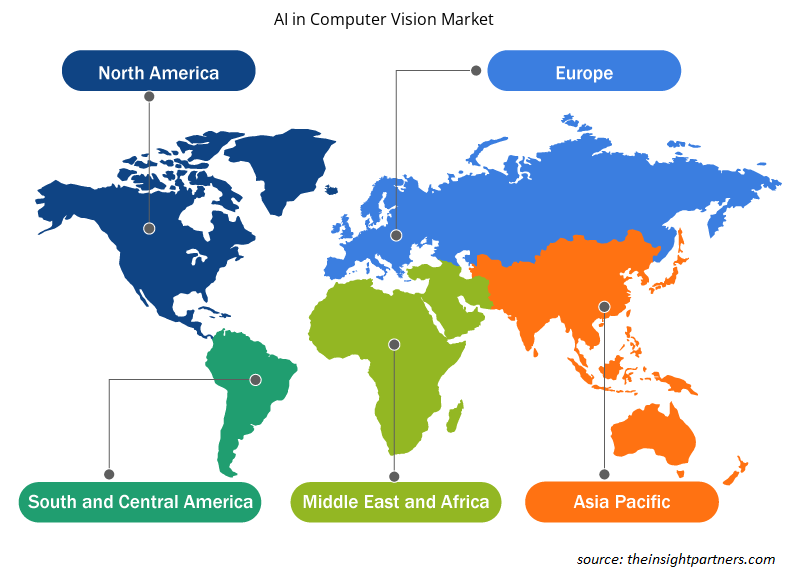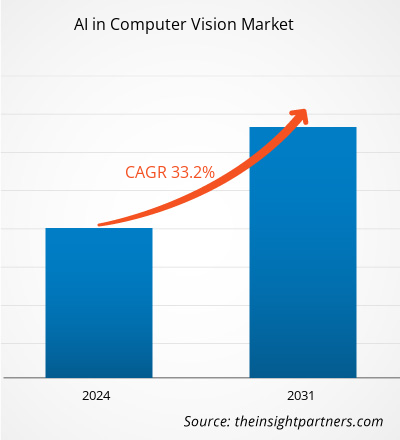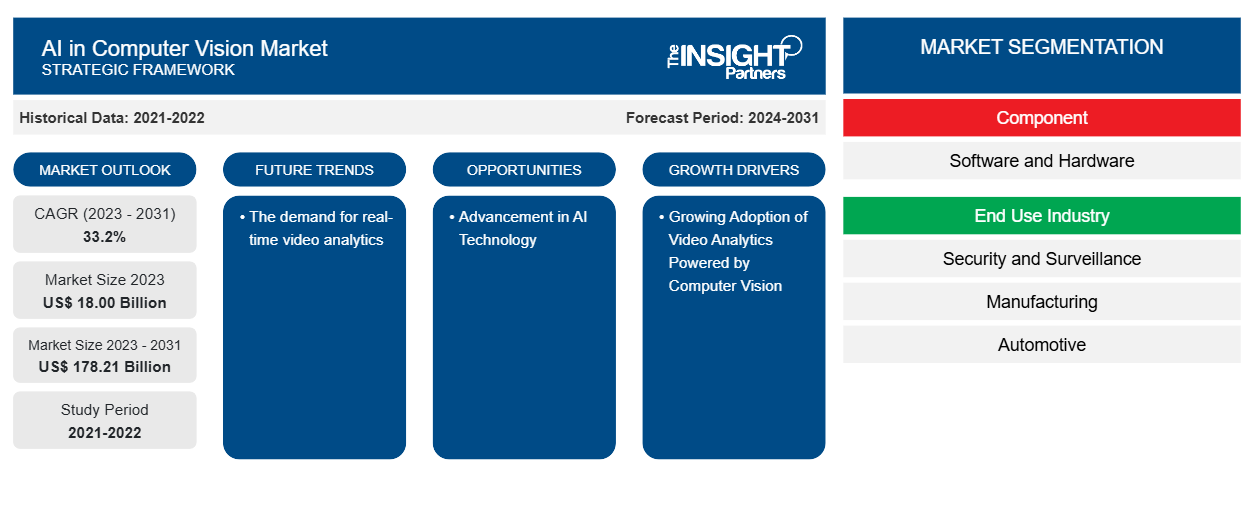[تقرير بحثي] تم تقييم حجم سوق الذكاء الاصطناعي في الرؤية الحاسوبية بنحو 13.75 مليار دولار أمريكي في عام 2022 ومن المتوقع أن يصل إلى 135.44 مليار دولار أمريكي بحلول عام 2030. ومن المتوقع أن يسجل سوق الذكاء الاصطناعي في الرؤية الحاسوبية معدل نمو سنوي مركب بنسبة 33.1٪ من عام 2022 إلى عام 2030.
وجهة نظر المحلل:
إن النمو في تبني الصناعة 4.0 يدفع نمو الذكاء الاصطناعي في سوق الرؤية الحاسوبية حيث تعمل الرؤية الحاسوبية للذكاء الاصطناعي على تحويل الصناعة 4.0 من خلال تمكين المركبات الآلية من تفسير وفهم المعلومات المرئية. إن الجمع بين الذكاء الاصطناعي والرؤية الحاسوبية يشبه وجود فريق من الروبوتات الخارقة القوة تعمل في عمليات المستودعات والخدمات اللوجستية. يمكن لهذه الروبوتات تحليل ورؤية واتخاذ القرارات بناءً على ما تلاحظه. الرؤية الحاسوبية هي تقنية أساسية لتطوير المركبات ذاتية القيادة أو ذاتية القيادة. إنها توفر قدرات الإدراك اللازمة، مما يمكن المركبات من التنقل والعمل بأمان دون تدخل بشري. وبالتالي، فإن العدد المتزايد من المركبات ذاتية القيادة يدفع نمو الذكاء الاصطناعي في سوق الرؤية الحاسوبية.
نظرة عامة على سوق الذكاء الاصطناعي في الرؤية الحاسوبية:
إن الذكاء الاصطناعي في مجال الرؤية الحاسوبية يمكّن أجهزة الكمبيوتر والأنظمة من استخلاص معلومات مفيدة من الصور الرقمية ومقاطع الفيديو وغيرها من المدخلات المرئية واتخاذ إجراءات أو عمل مراجع بناءً على تلك المعلومات. تعتمد تقنية الرؤية الحاسوبية بشكل كبير على تقنيات الذكاء الاصطناعي والتعلم الآلي. يمكّن الذكاء الاصطناعي الرؤية الحاسوبية من فهم جميع أنواع البيانات المرئية والتعرف عليها وتحليلها. يمكن لنماذج الذكاء الاصطناعي والمنطق والنماذج أن تستهلك وتستوعب وتتعلم بسرعة من كمية هائلة من البيانات المرئية المصنفة وغير المصنفة. إنه يمكّن أجهزة الكمبيوتر التي تدعم الرؤية الحاسوبية من التعرف على الميزات والأنماط والعلاقات المتنوعة في مقاطع الفيديو والرسومات وحتى الرسوم البيانية.
الهدف من الذكاء الاصطناعي في مجال الرؤية الحاسوبية هو إنشاء أنظمة آلية يمكنها فهم المعلومات المرئية (مثل الصور أو مقاطع الفيديو) بنفس الطريقة التي يفهمها بها البشر. تهدف الرؤية الحاسوبية إلى تعليم الآلات فهم الصور وتفسيرها بكسلًا بكسلًا. هناك العديد من حالات الاستخدام للرؤية الحاسوبية المدعومة بالذكاء الاصطناعي. تُستخدم الرؤية الحاسوبية في العديد من الصناعات مثل الأمن والمراقبة والتصنيع والسيارات وتجارة التجزئة والرياضة والترفيه والرعاية الصحية.
قم بتخصيص هذا التقرير ليناسب متطلباتك
ستحصل على تخصيص لأي تقرير - مجانًا - بما في ذلك أجزاء من هذا التقرير، أو تحليل على مستوى الدولة، وحزمة بيانات Excel، بالإضافة إلى الاستفادة من العروض والخصومات الرائعة للشركات الناشئة والجامعات
- احصل على أهم اتجاهات السوق الرئيسية لهذا التقرير.ستتضمن هذه العينة المجانية تحليلاً للبيانات، بدءًا من اتجاهات السوق وحتى التقديرات والتوقعات.
محركات سوق الذكاء الاصطناعي في الرؤية الحاسوبية:
التبني المتزايد للصناعة 4.0 يدفع الذكاء الاصطناعي إلى النمو في سوق الرؤية الحاسوبية
تُعَد الصناعة 4.0 مرحلة جديدة من الثورة الصناعية ــ التحول الرقمي للصناعات التحويلية والصناعات ذات الصلة ــ التي تؤكد بشدة على الأتمتة والترابط والبيانات في الوقت الفعلي والتعلم الآلي. ومن خلال الجمع بين الصناعة 4.0 وأنظمة الأتمتة، تتطور المرافق الصناعية التقليدية تدريجيًا إلى مرافق آلية ذكية ومتصلة وعالية الكفاءة. وهي تشكل وحدة آلية واحدة تجمع بين أجهزة الكمبيوتر وحلول الأتمتة الصناعية بمساعدة الروبوتات. وتخلق شبكة من الأجهزة المتصلة بنية ذكية قادرة على اتخاذ قرارات لامركزية. ومن المتوقع أن يؤدي التبني المتزايد لحلول الرؤية الحاسوبية القائمة على الذكاء الاصطناعي بين شركات الصناعة 4.0 إلى تحسين سلامة المستودعات، والسماح للشركات بتحقيق مستويات أعلى من التصنيع المرن، وزيادة الإنتاجية والربحية مع خفض التكاليف على المدى الطويل.
علاوة على ذلك، تعمل رؤية الكمبيوتر بالذكاء الاصطناعي على تحويل الصناعة 4.0 من خلال تمكين المركبات الآلية من تفسير وفهم المعلومات المرئية. إن الجمع بين الذكاء الاصطناعي ورؤية الكمبيوتر يشبه وجود فريق من الروبوتات الخارقة التي تعمل في عمليات المستودعات والخدمات اللوجستية. يمكن لهذه الروبوتات تحليل ورؤية واتخاذ القرارات بناءً على ما تلاحظه. يؤدي هذا إلى سير عمل أكثر دقة وكفاءة وتبسيطًا، مما يؤدي إلى زيادة الربحية والإنتاجية. في بيئة المستودعات والخدمات اللوجستية، يمكن لهذه الروبوتات أداء مهام مثل مراقبة الجودة والتعرف على الكائنات وتحديدها والاختيار والتعبئة وإدارة المخزون. إنها تساعد في العمل بوتيرة أسرع وتزيل احتمالية الخطأ البشري، والتأكد من وصول المنتجات الصحيحة إلى العملاء المناسبين في الوقت المحدد وضمان التدفق السلس للعمليات.
تُحدث رؤية الكمبيوتر بالذكاء الاصطناعي ثورة في عمليات الصناعة من خلال تقليل الخطأ البشري، وأتمتة المهام، وزيادة الإنتاجية، وتمكين اتخاذ القرارات الذكية بناءً على البيانات في الوقت الفعلي، وضمان جودة المنتج. هناك العديد من تطبيقات أنظمة رؤية الكمبيوتر بالذكاء الاصطناعي في الأتمتة للصناعة 4.0. باستخدام رؤية الكمبيوتر، تقيس كميات المنتجات بدقة وسرعة، وتقلل التكاليف والجداول الزمنية، وتتجنب الاتصال البشري في معالجة معينة للقضاء على مخاطر التلوث، وتضمن معايير سلامة أفضل للموظفين. تنمو رؤية الكمبيوتر بالذكاء الاصطناعي بسرعة في العالم الصناعي لأنها تقدم حلولاً قابلة للتكامل في خطوط الإنتاج. يمكن لنظام رؤية الكمبيوتر إجراء العديد من العمليات، بما في ذلك مراقبة المنتجات، وتحليل العيوب المحتملة، وإجراء الصيانة التنبؤية لتجنب الأعطال والانقطاعات، وتحسين السلامة في مواقع الإنتاج. وبالتالي، مع التبني المتزايد للصناعة 4.0، ينمو سوق الذكاء الاصطناعي في رؤية الكمبيوتر .
تقرير سوق الذكاء الاصطناعي في الرؤية الحاسوبية – التجزئة والنطاق:
يتم تقسيم سوق الذكاء الاصطناعي في الرؤية الحاسوبية إلى مكونات وصناعة الاستخدام النهائي والجغرافيا. بناءً على المكون، يتم تقسيم سوق الذكاء الاصطناعي في الرؤية الحاسوبية إلى أجهزة وبرامج. من حيث صناعة الاستخدام النهائي، يتم تقسيم سوق الذكاء الاصطناعي في الرؤية الحاسوبية إلى الأمن والمراقبة والتصنيع والسيارات والتجزئة والرياضة والترفيه وغيرها. من حيث الجغرافيا، يتم تقسيم سوق الذكاء الاصطناعي في الرؤية الحاسوبية إلى أمريكا الشمالية وأوروبا ومنطقة آسيا والمحيط الهادئ والشرق الأوسط وأفريقيا وأمريكا الجنوبية.
تحليل قطاعات سوق الذكاء الاصطناعي في الرؤية الحاسوبية:
بناءً على المكون، يتم تقسيم سوق الذكاء الاصطناعي في رؤية الكمبيوتر إلى أجهزة وبرامج. احتل قطاع البرامج حصة أكبر من سوق الذكاء الاصطناعي في رؤية الكمبيوتر في عام 2022. يلعب البرنامج دورًا مهمًا في الذكاء الاصطناعي في رؤية الكمبيوتر من خلال توفير الأدوات اللازمة لتحليل البيانات وتصورها. يوفر البرنامج العديد من التطبيقات مثل أطر عمل الذكاء الاصطناعي، وروتينات الذكاء الاصطناعي، ومعالجة الفيديو، واكتساب الصور، والتحكم في معالجة الصور، ووظائف الذكاء الاصطناعي لتصميم وتطوير ونشر تطبيقات رؤية الكمبيوتر عالية الأداء. يوفر العديد من اللاعبين برامج للذكاء الاصطناعي في رؤية الكمبيوتر. على سبيل المثال، توفر شركة Advanced Micro Devices Inc. برنامج AMD ROCm. يوفر البرنامج مجموعة من التحسينات لأحمال عمل الذكاء الاصطناعي - من نماذج اللغة الكبيرة (LLMs) إلى اكتشاف الصور / الفيديو والتعرف عليها، وعلوم الحياة واكتشاف الأدوية، والقيادة الذاتية، والروبوتات، والمزيد - ويدعم نظامًا بيئيًا أوسع لبرامج الذكاء الاصطناعي، بما في ذلك الأطر المفتوحة والنماذج والأدوات.
تلعب الأجهزة دورًا رئيسيًا في التقاط البيانات أثناء تطبيقات الرؤية الحاسوبية. العناصر الأساسية للأجهزة المطلوبة لتطبيقات الرؤية الحاسوبية هي وحدة المعالج وجهاز الإدخال/الإخراج (I/Os) والكاميرات وأجهزة استشعار الصور لالتقاط الصور ورابط الاتصال. تتميز أجهزة استشعار التصوير بالكاميرا بثلاثة معلمات رئيسية: الدقة (عدد البكسل) والسرعة (إطارات في الثانية) وعدد الألوان. اعتمادًا على نوع تطبيق الرؤية الحاسوبية، تختلف وحدات المعالجة من وحدات المعالجة المركزية إلى اللوحات المضمنة. توفر العديد من الشركات في جميع أنحاء العالم أجهزة للرؤية الحاسوبية. على سبيل المثال، توفر شركة Qualcomm Technologies, Inc. مجموعة تطوير Vision AI لتشغيل نماذج الذكاء الاصطناعي على الأجهزة الموجودة على الحافة الذكية. تتضمن مجموعة تطوير Vision AI لوحة رئيسية وكاميرا وغيرها.
تحليل إقليمي لسوق الذكاء الاصطناعي في الرؤية الحاسوبية:
تم تقييم حجم سوق الذكاء الاصطناعي في رؤية الكمبيوتر في أمريكا الشمالية بـ 5.01 مليار دولار أمريكي في عام 2022 ومن المتوقع أن يصل إلى 51.12 مليار دولار أمريكي بحلول عام 2030؛ ومن المتوقع أن يسجل معدل نمو سنوي مركب بنسبة 33.7٪ من عام 2022 إلى عام 2030. يتم تقسيم سوق الذكاء الاصطناعي في رؤية الكمبيوتر في أمريكا الشمالية إلى الولايات المتحدة وكندا والمكسيك. احتلت الولايات المتحدة أكبر حصة في سوق الذكاء الاصطناعي في رؤية الكمبيوتر في أمريكا الشمالية في عام 2022. ساهمت العديد من المنظمات التجارية والحكومات الفيدرالية والولائية في الولايات المتحدة في نمو السوق من خلال التبني السريع لتكنولوجيا الذكاء الاصطناعي للتنمية الصناعية والاقتصادية. تؤدي نيويورك أداءً جيدًا بشكل خاص في تكامل الذكاء الاصطناعي وجودة التطبيق كمركز مالي وتقني في الولايات المتحدة. بالإضافة إلى ذلك، من المتوقع أيضًا أن تؤثر مبادرة الحكومة للمدن الذكية في جميع أنحاء البلاد على اعتماد الذكاء الاصطناعي في تقنيات رؤية الكمبيوتر في جميع أنحاء البلاد. تطلق العديد من الشركات في الولايات المتحدة تقنيات رؤية الكمبيوتر. على سبيل المثال، في مايو 2023، أعلنت شركة Landing AI، وهي منصة السحابة الرائدة للرؤية الحاسوبية، عن أول برنامج رؤية حاسوبية في العالم للمصنعين الخاضعين لرقابة إدارة الغذاء والدواء. يستهدف إصدار المنصة هذا الصناعات الخاضعة للتنظيم الشديد، مثل شركات الأدوية والأجهزة الطبية وعلوم الحياة، حتى تتمكن من تسريع الحلول المبتكرة. وبالتالي، فإن سوق الذكاء الاصطناعي في الرؤية الحاسوبية ينمو في الولايات المتحدة.
تحليل اللاعبين الرئيسيين في سوق الذكاء الاصطناعي في الرؤية الحاسوبية:
تعد شركة Advanced Micro Devices Inc.، وشركة Cognex Corp.، وشركة General Electric Co.، وشركة Intel Corp.، وشركة Microsoft Corp.، وشركة Qualcomm Inc.، وشركة Teledyne Technologies Inc.، وشركة NVIDIA Corp.، وشركة BASLER AG، وشركة International Business Machines Corp. من بين الشركات الرئيسية العاملة في سوق الذكاء الاصطناعي في الرؤية الحاسوبية.
رؤى إقليمية حول سوق الذكاء الاصطناعي في مجال الرؤية الحاسوبية
لقد قام المحللون في Insight Partners بشرح الاتجاهات والعوامل الإقليمية المؤثرة على سوق الذكاء الاصطناعي في الرؤية الحاسوبية طوال فترة التوقعات بشكل شامل. يناقش هذا القسم أيضًا قطاعات سوق الذكاء الاصطناعي في الرؤية الحاسوبية والجغرافيا في أمريكا الشمالية وأوروبا ومنطقة آسيا والمحيط الهادئ والشرق الأوسط وأفريقيا وأمريكا الجنوبية والوسطى.

- احصل على البيانات الإقليمية المحددة لسوق الذكاء الاصطناعي في الرؤية الحاسوبية
نطاق تقرير سوق الذكاء الاصطناعي في الرؤية الحاسوبية
| سمة التقرير | تفاصيل |
|---|---|
| حجم السوق في عام 2023 | 18.00 مليار دولار أمريكي |
| حجم السوق بحلول عام 2031 | 178.21 مليار دولار أمريكي |
| معدل النمو السنوي المركب العالمي (2023 - 2031) | 33.2% |
| البيانات التاريخية | 2021-2022 |
| فترة التنبؤ | 2024-2031 |
| القطاعات المغطاة | حسب المكون
|
| المناطق والدول المغطاة | أمريكا الشمالية
|
| قادة السوق وملفات تعريف الشركات الرئيسية |
|
كثافة اللاعبين في سوق الذكاء الاصطناعي في مجال الرؤية الحاسوبية: فهم تأثيرها على ديناميكيات الأعمال
يشهد سوق الذكاء الاصطناعي في مجال الرؤية الحاسوبية نموًا سريعًا، مدفوعًا بالطلب المتزايد من المستخدم النهائي بسبب عوامل مثل تفضيلات المستهلكين المتطورة والتقدم التكنولوجي والوعي المتزايد بفوائد المنتج. ومع ارتفاع الطلب، تعمل الشركات على توسيع عروضها والابتكار لتلبية احتياجات المستهلكين والاستفادة من الاتجاهات الناشئة، مما يؤدي إلى زيادة نمو السوق.
تشير كثافة اللاعبين في السوق إلى توزيع الشركات أو المؤسسات العاملة في سوق أو صناعة معينة. وهي تشير إلى عدد المنافسين (اللاعبين في السوق) الموجودين في مساحة سوق معينة نسبة إلى حجمها أو قيمتها السوقية الإجمالية.
الشركات الرئيسية العاملة في سوق الذكاء الاصطناعي في الرؤية الحاسوبية هي:
- شركة ادفانسد مايكرو ديفايسز
- شركة كوجنكس
- شركة جنرال الكتريك
- شركة إنتل
- شركة مايكروسوفت
- شركة كوالكوم
إخلاء المسؤولية : الشركات المذكورة أعلاه ليست مرتبة بأي ترتيب معين.

- احصل على نظرة عامة على أهم اللاعبين الرئيسيين في سوق الذكاء الاصطناعي في الرؤية الحاسوبية
التطورات الأخيرة في سوق الذكاء الاصطناعي في الرؤية الحاسوبية:
تتبنى الشركات في سوق الذكاء الاصطناعي في مجال الرؤية الحاسوبية بشكل كبير الاستراتيجيات العضوية وغير العضوية مثل عمليات الدمج والاستحواذ. وفيما يلي بعض التطورات الرئيسية الأخيرة في سوق الذكاء الاصطناعي في مجال الرؤية الحاسوبية:
- في فبراير 2022، أعلنت AMD عن استحواذها على Xilinx، وهي شركة متخصصة في تصنيع أشباه الموصلات ومقرها الولايات المتحدة. وبعد الاستحواذ، ستعمل Xilinx الآن كجزء من مجموعة الحوسبة التكيفية والمدمجة التابعة لشركة AMD. وتقدم كلتا الشركتين منتجات تكميلية مع حقوق ملكية فكرية وقوى عاملة متميزة. ومن خلال العمل معًا، ستتمكن AMD وXilinx من تقديم منتجات وحلول أوسع نطاقًا تلبي كل احتياجات حلول الحوسبة.
- في مارس 2023، عززت مختبرات Intel تطوير الرؤية الحاسوبية من خلال نموذجين جديدين للذكاء الاصطناعي. تعمل نماذج الذكاء الاصطناعي مفتوحة المصدر VI-Depth 1.0 وMiDaS 3.1 على تحسين تقدير العمق للرؤية الحاسوبية.
- التحليل التاريخي (سنتان)، سنة الأساس، التوقعات (7 سنوات) مع معدل النمو السنوي المركب
- تحليل PEST و SWOT
- حجم السوق والقيمة / الحجم - عالمي، إقليمي، بلد
- الصناعة والمنافسة
- مجموعة بيانات إكسل
التقارير الحديثة
تقارير ذات صلة
شهادات العملاء
سبب الشراء
- اتخاذ قرارات مدروسة
- فهم ديناميكيات السوق
- تحليل المنافسة
- رؤى العملاء
- توقعات السوق
- تخفيف المخاطر
- التخطيط الاستراتيجي
- مبررات الاستثمار
- تحديد الأسواق الناشئة
- تحسين استراتيجيات التسويق
- تعزيز الكفاءة التشغيلية
- مواكبة التوجهات التنظيمية























 احصل على عينة مجانية ل - الذكاء الاصطناعي في سوق الرؤية الحاسوبية
احصل على عينة مجانية ل - الذكاء الاصطناعي في سوق الرؤية الحاسوبية